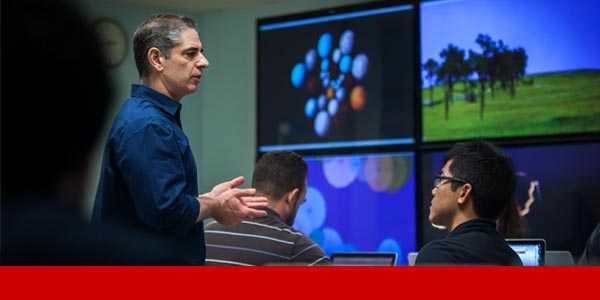Faculty Spotlight: Ira Greenberg

Ira Greenberg lives a protean life. A combination computer science expert and traditional artist, he is conversant in coding and Cézanne, algorithms and abstractions.
Greenberg, a faculty member for the online Master of Science in Data Science program, is also director of SMU’s Center of Creative Computation and leader of the SMU-in-Tokyo study abroad program. He has two grants from the National Science Foundation to further the field of teaching computer science in higher education, and he is the author/co-author of three books on Processing. Greenberg is a family man, husband to Robin and dad to Ian and Sophie. He loves hockey and he loves his pets, a menagerie of dogs, guinea pigs and a cat.
He is often thought of as “the computer guy,” but Greenberg is very much an artist. His most recent work, “Embodied Algorithm: [Re]embracing the Analog” is currently showing at the SMU Hamon Library Hawn Gallery. The exhibit explores the flow between computational- and human-implemented algorithms.
Below, Greenberg chats about coding, art, his new exhibit, and why visualization is a skill that every data scientist needs in his or her toolkit:
Visualization is part of the DataScience@SMU program’s curriculum. Why do data scientists need to know about visualization?
Greenberg (G): It’s the creativity factor. Visualization takes data beyond something that is dry and convoluted. It helps people see the ideas, the plans, the concepts. It can provide understanding and excitement about what the data represents. When a data scientist is trying to explain ideas to someone outside of the field — the general public, people in the sales or marketing department, or new clients – visualization can clarify and amplify the concept.
I teach programming and technical stuff but in many ways, I teach creativity. Like, how do we impose structure over chaos in our processes? There is a certain amount of creativity with coding: How do we think out of the box, and how do we not just solve the problem, how do we create something that’s really unexpected and engaging and hopefully beautiful?
In your new show at the Hawn Gallery, you say the drawings have a genesis in algorithms?
G: Yeah, the show is actually about the transition of me doing these drawings that were inspired by digital processes in my coding. Over a two-and-a-half-year period, the drawings slowly transformed from almost analog algorithms – where I was drawing intricate patterns, and I was searching for patterns in the drawing process in the same way a program might run an algorithm during some type of search. From that process, it wound up turning into drawings of heads, and then the heads became a little bit more representational. I started doing some studies of real heads to inform the process. That process just took over, and I ended up doing this whole series of heads from these observations. So, it’s really sort of about that transformation from the digital to the analog.

How do they look organic, while some look like a machine was involved? What’s happening here?
G: I started thinking about how a human would simulate this process. In coding, we always simulate human processes in the computer; I wanted to simulate a computer process as a human. These drawings came about with me just starting to scribble on a paper, then seeing what habitual patterns or forms I was making, then bringing those out and letting the work be about that.
Can you walk through your creative thought process for this collection?
G: Let’s say we’re going to write some code, and we’re not writing code to serve a specific purpose, not trying to build a bridge or get a database to work, we’re just writing code.
Often, we’ll get some idea of what’s happening on the code, whether we’re drawing a line or getting some text to come up. Then we start iterating, sort of poking at it, making little changes, randomizing it, changing it, this way, that way, then we add much more, and then once we have a lot of stuff that’s starting to be interesting, we start to see how we can organize it in different ways using logic.
For instance, when I code, I can make rules that say when I draw a line this way, until I find a line moving at this angle, then I change the direction of the line that was coming toward it. So, I have a whole series of rules that come into play that establish how the drawing emerges. When I start, I don’t know what it’s going to look like –it emerges as I work on it.
I thought to myself, how does a human do this? Forgetting about a machine, say I become the machine, and I wanted to do this myself as a person who draws, can I sort of simulate this process as a human?
Good data scientists are skilled in applying algorithms, statistics and other quantitative methods, but the truly great ones will also be creative problem solvers and visual thinkers. The Visualization of Information course sequence provides the framework to help students develop creative competency and ultimately professional competitive advantage.
Embodied Algorithm: [Re]embracing the Analog will be on view until October 8. The Hawn Gallery is located in the Hamon Arts Library in Meadows School of the Arts Owen Arts Center. The gallery is open daily, Monday-Thursday 8 a.m. -9 p.m., Friday 8 a.m. – 6 p.m., Saturday 12 p.m. – 5 p.m., and Sunday 2 p.m. -9 p.m. and is free to the public. The artwork will extend out of the Hawn Gallery and into the Hamon Arts Library’s lobby to include works from the artist’s algorithmic drawing series.
For more information, please call 214-768-3813 or visit http://www.smu.edu/cul/hamon.
Last updated September 2017


